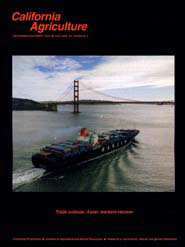All Issues

Trade outlook: Asian markets recover
Cover:
A Korean container ship heads through Golder Gate toward points east after receiving freight at the Port of Oakland, the top exporting port on the West Coast. In 1998, one-third of the freight shipped from Oakland was agricultural commodities. See pages 6 and 7... © Robert Campbell, Courtesy Port of Oakland
September-October 1999
Volume 53, Number 5
Volume 53, Number 5





